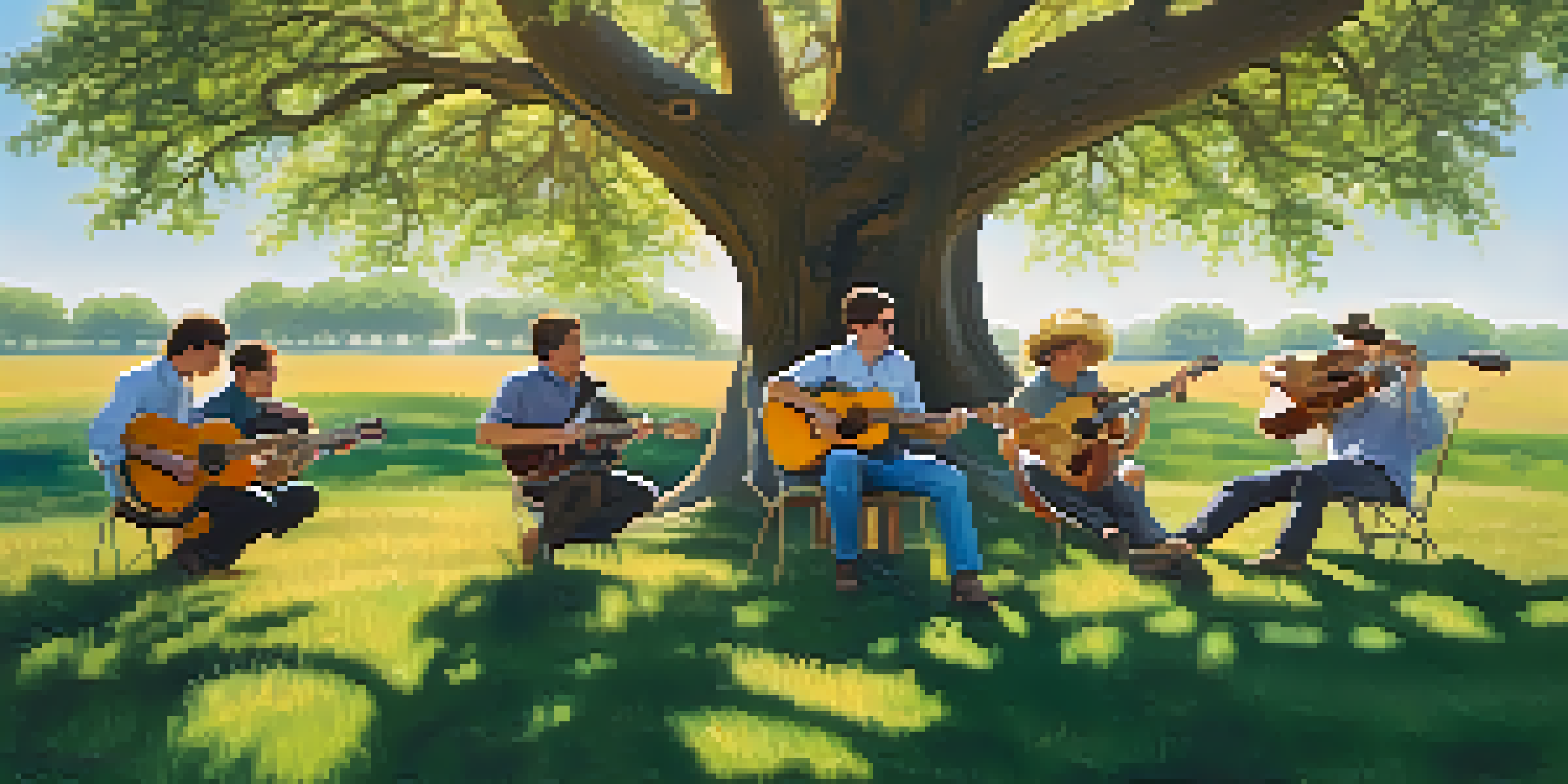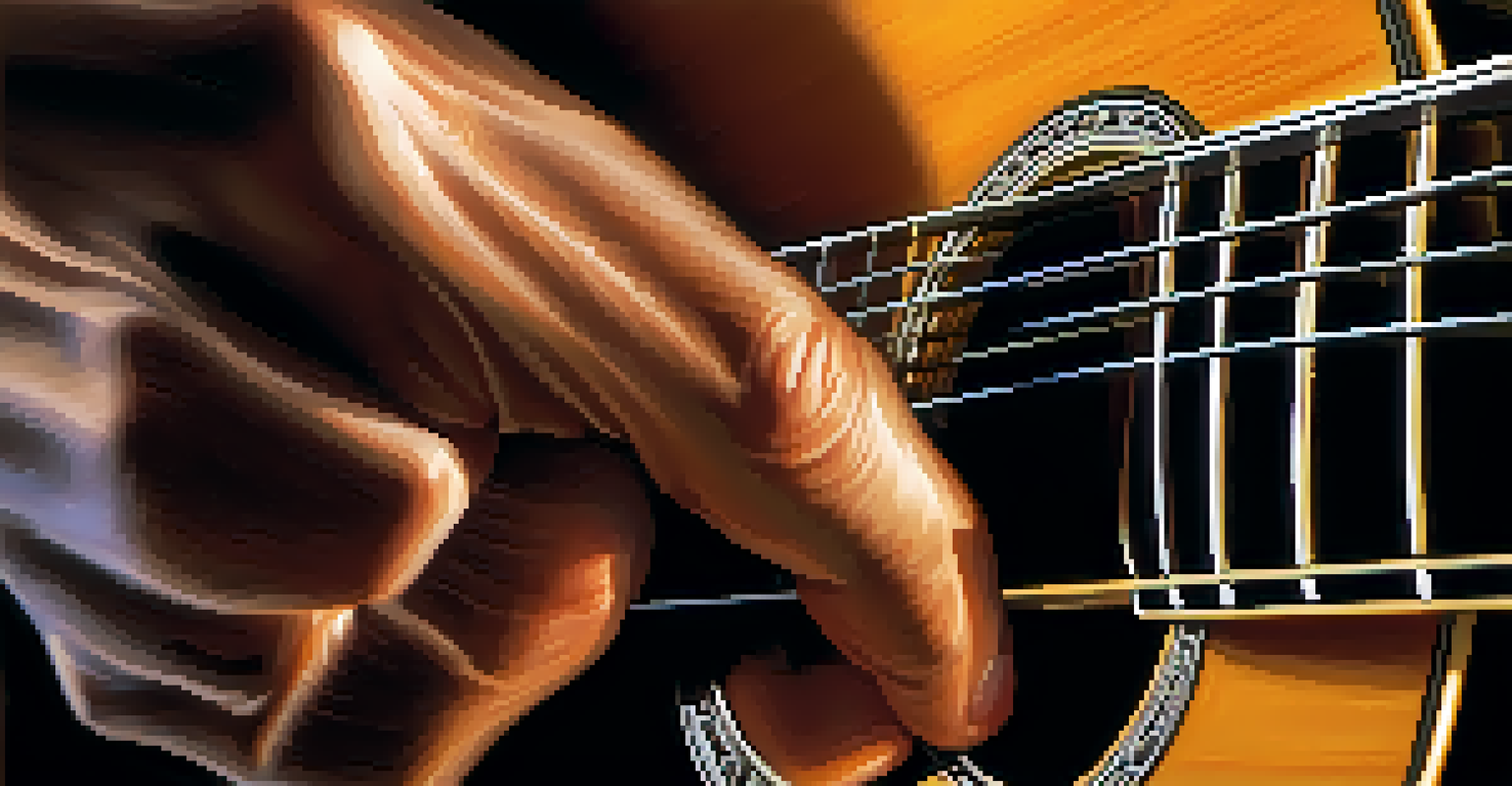Creating Effective Arrangements for Guitar Ensembles

Understanding the Basics of Guitar Arrangements
Creating effective arrangements for guitar ensembles begins with a solid understanding of the instruments involved. Each guitar has a unique voice, whether it’s an acoustic, electric, or classical guitar, and knowing these differences will help you make better musical choices. Think of it as assembling a puzzle; each piece must fit together to create a cohesive picture.
Music is the shorthand of emotion.
A good starting point is to identify the roles within the ensemble. For example, one guitar might take on the melody, while others provide harmony or rhythm. This division of labor not only clarifies the arrangement but also allows each guitarist to shine in their respective role, much like actors in a play where everyone has their moment in the spotlight.
Moreover, understanding basic music theory, such as chord structures and scales, will enhance your arrangements significantly. It’s like having a map that guides you through the musical landscape, helping you navigate the complexities of harmonies and progressions.
Choosing the Right Key for Your Ensemble
Selecting the appropriate key for your arrangement is crucial. The key sets the mood and can greatly affect how the music feels. Consider the strengths and weaknesses of the players in your ensemble; certain keys may be easier to play for some than others, which can make a big difference in performance quality.

For example, if you have a guitarist who excels in playing in E major but struggles with B flat minor, it might be wise to choose a key that highlights their strengths. This not only boosts their confidence but also enhances the overall sound of the ensemble. Imagine trying to run a race with shoes that don’t fit—picking the right key is like ensuring everyone is comfortable and ready to give their best.
Understand Roles in Guitar Arrangements
Identifying the roles within a guitar ensemble helps create effective arrangements where each player shines.
Additionally, experimenting with different keys can lead to interesting textures and dynamics. Sometimes, a simple transposition can breathe new life into a piece, making it sound fresh and engaging, much like adding a splash of color to a monochrome painting.
Incorporating Dynamics and Articulation
Dynamics and articulation are essential elements that can elevate your guitar arrangement. They add depth and emotional expression, helping to convey the story behind the music. Think of dynamics as the volume of your piece—soft passages can create intimacy, while louder sections can evoke excitement.
The beautiful thing about learning is that no one can take it away from you.
Articulation refers to how notes are played, whether they’re crisp and detached or smooth and connected. Incorporating varied articulation adds texture to your arrangement, making it more engaging for both players and listeners. It’s akin to using different brushstrokes in painting; each technique contributes to the overall masterpiece.
Encouraging your ensemble to explore different dynamics and articulations can foster creativity and collaboration. This experimentation can lead to unique interpretations of the music, turning a simple arrangement into a vibrant performance that resonates with the audience.
Creating Interesting Harmonies and Voicings
Harmonies and voicings are where your creativity can truly shine in guitar arrangements. Instead of sticking to basic triads, consider using extended chords or different voicings to create richer textures. Just like a chef adds spices to enhance a dish, using varied harmonies can elevate your music to new heights.
For instance, if one guitarist plays a melody in the higher register, another can complement it by playing harmonies in the lower register. This layering creates a fuller sound, similar to an orchestra where different sections blend together to enrich the musical experience. Experimenting with inversions and different fingerings can also lead to unique sounds.
Choose the Right Key for Comfort
Selecting a key that aligns with players' strengths enhances performance quality and boosts confidence.
Moreover, incorporating counterpoint, where melodies intertwine, can add complexity and intrigue to your arrangement. It’s like a conversation between friends—each voice has its own perspective, yet together they create a harmonious dialogue.
Utilizing Rhythm and Groove Effectively
Rhythm and groove are the heartbeat of any musical arrangement. In a guitar ensemble, establishing a strong rhythmic foundation is essential to keep the group cohesive and engaged. Think of it as the pulse of a living organism; without it, the music can feel disjointed and lifeless.
Encouraging the ensemble to explore various rhythms can lead to exciting results. You might choose to incorporate syncopation or polyrhythms, which add complexity and interest. This is similar to adding layers to a cake—each layer brings its own flavor, creating a delightful experience for the listener.
Additionally, maintaining a consistent groove helps unify the ensemble. Practicing together and developing a shared sense of timing ensures that each player is in sync, much like dancers moving in harmony on stage. This unity allows the music to flow seamlessly and captivates the audience.
Arranging for Different Skill Levels
When arranging for a guitar ensemble, it's important to consider the varying skill levels of the players. This is akin to assembling a team where each member has a unique set of strengths and weaknesses. By tailoring parts to each guitarist’s abilities, you can create an inclusive environment that fosters growth and enjoyment.
For instance, you might assign simpler parts to less experienced players while providing more challenging lines to advanced musicians. This approach not only boosts the confidence of beginner players but also ensures that the overall sound remains balanced and harmonious. It’s like ensuring everyone on a sports team has a role that plays to their strengths.
Focus on Dynamics and Articulation
Incorporating varied dynamics and articulation adds depth and emotional expression to your guitar arrangements.
Encouraging collaboration among players can also lead to creative solutions. Experienced musicians can help guide their peers, fostering a sense of camaraderie and shared purpose within the ensemble, which ultimately enhances the performance.
Rehearsing and Polishing Your Arrangements
Once you’ve crafted your arrangement, the next step is rehearsal. This phase is crucial for refining the details and ensuring that the ensemble is tight and cohesive. Think of it like sculpting; you start with a rough shape and gradually refine it until it shines.
During rehearsals, pay attention to dynamics, rhythm, and communication among players. Regular feedback is essential; it helps identify areas that need improvement and fosters a growth mindset within the group. Just as actors rehearse their lines repeatedly, musicians need practice to bring their arrangement to life.

Finally, don’t forget to record rehearsals whenever possible. Listening back allows you to hear what works and what doesn’t, providing valuable insights for further refinement. This self-reflection is like reviewing a game tape, helping you strategize for an even better performance.
Performing and Sharing Your Ensemble's Music
The final step in the process is performing your arrangement. This is where all the hard work pays off, and the ensemble gets to share their music with an audience. It’s like the grand unveiling of a masterpiece—exciting and nerve-wracking all at once!
During performances, encourage the players to express themselves and connect with the audience. This emotional engagement can elevate the experience for everyone involved, creating a memorable moment that resonates long after the last note. Think of it as a storyteller sharing a powerful tale, drawing the audience into the narrative.
Finally, consider recording your performances to share with a wider audience. Platforms like social media allow you to showcase your ensemble’s work, fostering a sense of community and connection with others who appreciate your music. In today’s digital age, sharing your art can inspire others and create lasting relationships within the music community.